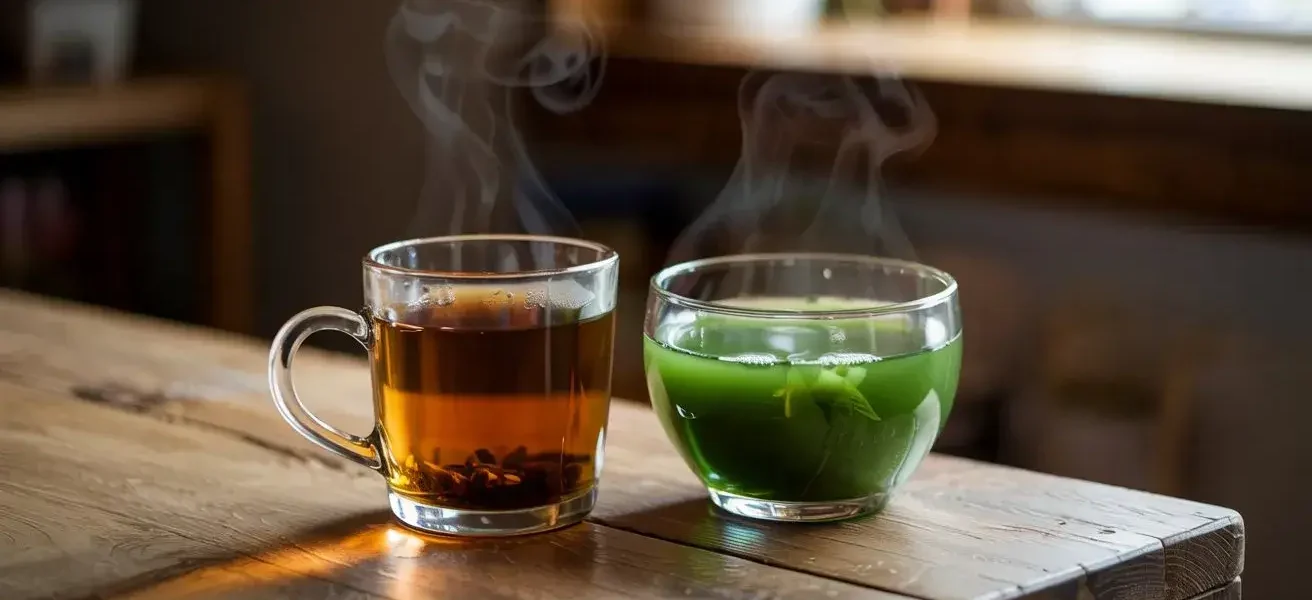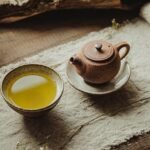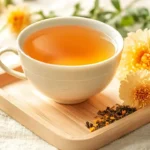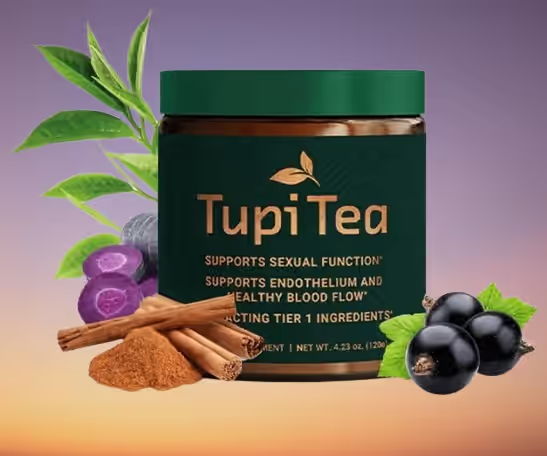Table of Contents
When it comes to choosing a refreshing drink, barley tea and green tea are two popular options. Each has its own unique taste, health benefits, and cultural significance. But how do they stack up against each other? In this article, we’ll explore the differences and similarities between barley tea vs green tea, helping you decide which brew might be the best fit for you.
Key Takeaways
- Barley tea is a caffeine-free infusion made from roasted barley grains, while green tea comes from the leaves of the Camellia sinensis plant.
- Both teas offer health benefits, with barley tea aiding digestion and green tea being rich in antioxidants.
- Caffeine levels differ significantly; barley tea has none, whereas green tea contains a moderate amount of caffeine.
- Brewing techniques vary: barley tea is often steeped longer for a stronger flavor, while green tea requires careful temperature control to avoid bitterness.
- Culturally, both teas hold significance, with barley tea being a staple in East Asian meals and green tea being central to Japanese tea ceremonies.
Understanding Barley Tea
Origins of Barley Tea
Barley tea isn’t like your typical tea; it’s more of a roasted grain infusion. Think of it as the beverage equivalent of comfort food. It’s super popular in East Asian countries like Japan, Korea, and China, where they call it by different names – mugicha in Japan, boricha in Korea, and damai cha in China. It’s often enjoyed as a refreshing alternative to water, especially during the hot summer months.
Flavor Profile of Barley Tea
Barley tea has a really mild, toasty flavor. It’s not bitter or overpowering like some other teas can be. Some people describe it as having a slightly nutty taste, which makes it really easy to drink. You can enjoy it hot or cold, but I personally think it tastes best when it’s chilled. It’s a great way to quench your thirst without all the sugar and artificial stuff you find in a lot of other drinks.
Health Benefits of Barley Tea
Barley tea isn’t just tasty; it also has some potential health benefits of barley tea. While it’s not a miracle cure, it’s packed with antioxidants and may help with digestion. Some studies suggest it could even aid in weight loss and boost your immune system. Plus, it’s caffeine-free, so you can drink it any time of day without worrying about staying up all night. The health benefits of barley tea are a great bonus to its refreshing taste. Here are some potential benefits:
- Rich in antioxidants
- May improve digestion
- Caffeine-free
Drinking barley tea can be a simple way to add some extra nutrients to your diet. It’s a good source of certain vitamins and minerals, contributing to overall well-being. While more research is needed to fully understand all its potential benefits, it’s a healthy and delicious beverage option to consider.
Here’s a quick look at some barley tea nutrition facts:
| Nutrient | Amount (per 8 oz serving) |
|---|---|
| Calories | Very Low |
| Antioxidants | High |
| Caffeine | 0 mg |
| Vitamins/Minerals | Trace Amounts |
Remember, the health benefits of barley tea are best enjoyed as part of a balanced diet and healthy lifestyle.
👉 Toasty & Refreshing – Sip Premium Barley Tea Today! 👈
Exploring Green Tea

History of Green Tea
Green tea has a rich history, dating back thousands of years to ancient China. Legend says it was discovered by Emperor Shennong around 2737 BCE when tea leaves accidentally fell into his boiling water. From there, its use spread throughout Asia, becoming a staple in many cultures. Over time, different regions developed their own unique methods of cultivation and preparation, leading to the diverse range of green teas we enjoy today. It’s interesting to see how a simple accident turned into such a widespread and beloved beverage.
Taste Characteristics of Green Tea
Green tea offers a wide spectrum of flavors, influenced by factors like the tea variety, growing conditions, and processing methods. Some common descriptors include grassy, vegetal, sweet, and slightly bitter. Sencha, for example, often has a fresh, grassy taste, while matcha is known for its creamy texture and umami flavor. The water temperature and steeping time also play a big role in the final taste. Too hot or too long, and you might end up with a bitter cup. Finding the right balance is key to unlocking the tea’s full potential. It’s a journey of experimentation to find what suits your palate best.
Health Benefits of Green Tea
Green tea is often praised for its potential health benefits, largely attributed to its high antioxidant content. These antioxidants, including catechins like EGCG, are thought to help protect against cell damage and reduce the risk of chronic diseases. Some studies suggest that regular green tea consumption may support heart health, brain function, and even weight management. Of course, it’s not a magic bullet, and more research is always needed. But incorporating green tea into a balanced lifestyle could be a simple way to potentially boost your well-being. It’s a nice bonus on top of enjoying a flavorful drink.
Green tea is often compared to green tea vs herbal tea, with many people wondering about the comparative tea benefits. While best herbal teas for health offer their own advantages, green tea stands out due to its unique composition and potential effects. There are many green tea advantages to consider, and a green tea comparison can help you decide what’s best for you.
👉 Refresh Your Senses – Sip Premium Green Tea Now! 👈
Caffeine Content Comparison

Caffeine Levels in Barley Tea
Barley tea is naturally caffeine-free. This makes it an excellent choice for those sensitive to caffeine or looking for a relaxing beverage before bed. Unlike many other teas, including green tea, you can enjoy barley tea any time of day without worrying about caffeine content in tea disrupting your sleep.
Caffeine Levels in Green Tea
Green tea, on the other hand, does contain caffeine, though typically less than coffee or black tea. The exact amount can vary depending on factors like the type of green tea, how it’s brewed, and the age of the leaves. Generally, you can expect a cup of green tea to have somewhere between 30 to 50 milligrams of caffeine. This can provide a gentle energy boost without the jitters associated with higher-caffeine drinks.
Effects of Caffeine on Health
Caffeine can have both positive and negative effects on health. Some people find that it improves focus and alertness, while others may experience anxiety, insomnia, or digestive issues. It’s important to be mindful of your own caffeine sensitivity and adjust your intake accordingly. Green tea offers some caffeine, but barley tea provides a caffeine-free alternative for those who want to avoid it altogether.
For some, caffeine is a welcome addition to their daily routine, providing a much-needed energy boost. However, for others, it can lead to unwanted side effects. Understanding how caffeine affects you personally is key to making informed choices about your tea consumption.
Brewing Techniques for Each Tea

How to Brew Barley Tea
Brewing barley tea is surprisingly simple. You don’t need fancy equipment, just some roasted barley and water. The key is to find the right balance between steeping time and flavor extraction.
First, you’ll need roasted barley grains. You can find these at most Asian grocery stores or online. Then:
- Boil water in a kettle or pot.
- Add the roasted barley to the boiling water. A good starting point is about 1-2 tablespoons of barley per 4 cups of water, but adjust to your taste.
- Let it simmer for about 15-20 minutes. This allows the flavor to infuse into the water without becoming too bitter.
- Strain the tea to remove the barley grains. You can use a fine-mesh strainer or cheesecloth.
- Serve hot or cold. Barley tea is great either way!
I like to make a big batch of barley tea and keep it in the fridge. It’s a super refreshing drink on a hot day, and it’s a nice alternative to sugary drinks. Plus, it’s one of the best types of tea for hydration.
How to Brew Green Tea
Green tea brewing is a bit more delicate than barley tea. Temperature is key here. You don’t want to use boiling water, as it can make the tea bitter.
- Heat water to around 175°F (80°C). A temperature-controlled kettle is helpful, but if you don’t have one, just let boiling water cool for a few minutes.
- Place green tea leaves in a teapot or infuser. The amount of tea depends on the type of green tea and your preference, but a teaspoon per cup is a good starting point.
- Pour the hot water over the tea leaves.
- Steep for 2-3 minutes. Don’t over-steep, or the tea will become bitter.
- Remove the tea leaves or infuser.
- Serve immediately. Green tea is best enjoyed fresh.
Tips for Perfecting Your Brew
To really nail your tea brewing, here are a few extra tips:
- For barley tea, experiment with roasting your own barley. This allows you to control the level of roast and the intensity of the flavor. Remember that brewing techniques for tea can vary widely.
- For green tea, use good quality tea leaves. The better the leaves, the better the tea. Also, consider exploring different types of green tea, like sencha, matcha, or gyokuro.
- Don’t be afraid to experiment with steeping times and water temperatures to find what works best for you. Everyone’s taste is different!
- Consider using filtered water for both barley and green tea. This can improve the taste by removing impurities. Some people also consider best herbal teas for their health benefits, but both barley and green tea have their own advantages.
- If you’re making a large batch of barley tea, you can re-steep the barley grains for a second, weaker brew. This is a good way to get the most out of your ingredients.
👉 Smooth, Nutty, Delicious – Try Top Barley Tea Now! 👈
Cultural Significance of Barley and Green Tea

Barley Tea in Asian Cultures
Barley tea isn’t just a drink; it’s woven into the fabric of daily life in many Asian countries. In Japan, it’s known as mugicha and is a summertime staple, often served cold. You’ll find it in almost every household. Korea calls it boricha, and it’s common to see it served both hot and cold, even given to kids as a healthier alternative to sugary drinks. China knows it as dàmài chá, and it’s traditionally used for its cooling properties, especially during hot weather. It’s more than just a beverage; it’s a cultural touchstone.
Green Tea Traditions
Green tea has a long and storied history, especially in China and Japan. It’s not just about drinking tea; it’s about the ritual and the connection to nature. Think about the serene tea gardens and the meticulous preparation. Green tea ceremonies are a big deal, emphasizing harmony, respect, purity, and tranquility. It’s a whole philosophy wrapped up in a cup.
Tea Ceremonies and Their Importance
Tea ceremonies, particularly in Japan (think Chanoyu), are elaborate rituals that go way beyond just brewing a cup of tea. They’re about creating a space for mindfulness and connection. The host carefully prepares the tea, and the guests participate in a specific way, all designed to promote a sense of peace and togetherness. These ceremonies aren’t just historical relics; they continue to be important for preserving cultural values and fostering a sense of community.
Tea ceremonies are a way to slow down and appreciate the present moment. They teach respect, humility, and the importance of simple pleasures. It’s a reminder to take a break from the hustle and bustle of daily life and find some inner peace.
Here are some key aspects of a traditional Japanese tea ceremony:
- The setting is usually a simple tea room designed to promote tranquility.
- Specific utensils and movements are used, each with its own significance.
- The tea is prepared and served with great care and attention to detail.
- Guests are expected to participate respectfully and mindfully.
Nutritional Profiles of Barley Tea and Green Tea

Vitamins and Minerals in Barley Tea
Barley tea, while not a significant source of macronutrients, does offer some vitamins and minerals. It’s known to contain trace amounts of vitamins A and C, along with antioxidants. However, the exact nutritional content can vary based on the barley type and brewing method. It’s also caffeine-free, making it a good choice for those sensitive to stimulants.
Vitamins and Minerals in Green Tea
Green tea is celebrated for its rich antioxidant profile, particularly catechins like EGCG. It also contains vitamins and minerals, though in small amounts. Here’s a quick rundown:
- Vitamin C
- Vitamin K
- Folic acid
- Potassium
- Caffeine (varying amounts)
Green tea’s health benefits are often attributed to its high concentration of antioxidants, which help combat free radicals in the body. These antioxidants are believed to play a role in reducing the risk of chronic diseases.
Comparative Nutritional Benefits
When it comes to a nutritional comparison of teas, green tea generally edges out barley tea due to its higher antioxidant content and presence of certain vitamins. However, barley tea’s caffeine-free nature makes it a preferable option for some. The caffeine content in barley and green tea is a key differentiator. While green tea offers a boost, barley tea provides hydration without the jitters.
Here’s a simple table summarizing the key differences:
| Feature | Barley Tea | Green Tea |
|---|---|---|
| Antioxidants | Moderate | High |
| Vitamins | A, C (trace) | C, K, Folic Acid |
| Minerals | Trace | Potassium |
| Caffeine | None | Present |
| Fiber | Minimal | Minimal |
| Sugar | Little natural sugar | Little natural sugar |
| Protein | Little to no | Little to no |
| Fat | None | None |
👉 Pure, Fresh, Powerful – Try Top Green Tea Today! 👈
Taste Test: Barley Tea vs Green Tea

Flavor Comparisons
Okay, let’s get down to the real deal: how do these teas actually taste? Barley tea usually has a mild, toasty, and slightly nutty flavor. Some people even detect a hint of bitterness, but it’s generally pretty subtle. Green tea, on the other hand, can vary wildly depending on the type. Some are grassy and vegetal, while others are more sweet or even a bit marine-like. It really depends on the processing and origin. I find that barley tea is more consistent, while green tea is more of an adventure for your taste buds.
Pairing Suggestions
Thinking about what to eat with your tea? Here are some ideas:
- Barley tea: Because of its mild flavor, barley tea pairs well with a lot of different foods. I like it with light snacks like rice crackers or even a simple salad. It’s also great with Asian dishes that aren’t too spicy.
- Green tea: Green tea is a bit more versatile. The grassy types go well with sushi or seafood, while the sweeter ones can handle pastries or fruit. Matcha, with its stronger flavor, can even stand up to chocolate.
- Experiment! Don’t be afraid to try different combinations and see what you like best.
Personal Preferences and Experiences
Ultimately, the best tea is the one you enjoy the most. I personally like barley tea when I want something refreshing and caffeine-free, especially in the summer. Green tea is my go-to when I need a little pick-me-up and want something with a bit more complexity. I’ve found that my preferences also change depending on the time of day and what I’m eating. It’s all about finding what works for you!
I remember the first time I tried barley tea. I was in Korea, and it was served cold at a restaurant. I was immediately hooked by its refreshing and slightly toasty flavor. It was the perfect drink for a hot day. Green tea, on the other hand, took me a bit longer to appreciate. I had to try a few different types before I found one that I really loved. Now, I’m a big fan of both!
Final Thoughts on Barley Tea and Green Tea
So, which one should you choose? It really comes down to what you’re looking for. If you want something refreshing and caffeine-free, barley tea is a solid pick. It’s got that nutty flavor and a bunch of health benefits, plus it’s super easy to make. On the flip side, if you’re after a boost of energy and a rich source of antioxidants, green tea might be your go-to. Both drinks have their own charm and perks, so why not switch it up? Enjoying both could be the best way to keep things interesting in your cup!
👉 A Soothing Japanese Favorite – Enjoy Premium Barley Tea! 👈
Frequently Asked Questions
What is barley tea made from?
Barley tea is made from roasted barley grains and water. It’s not a true tea because it doesn’t come from tea leaves.
Is barley tea caffeine-free?
Yes, barley tea is completely caffeine-free, making it a great option for those who want to avoid caffeine.
What are the health benefits of barley tea?
Barley tea can help with digestion, is high in antioxidants, and supports heart health. It’s also hydrating!
How do you brew barley tea?
To brew barley tea, boil roasted barley in water for about 15-20 minutes, then strain and enjoy hot or cold.
Can I drink barley tea every day?
Yes, you can drink barley tea every day! It’s a healthy and refreshing beverage.
What does barley tea taste like?
Barley tea has a mild, nutty flavor that is slightly toasty and sweet, making it very pleasant to drink.













